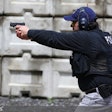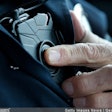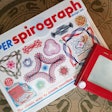In the last decade, there has been a significant rise in the number of officers killed in training by live weapons. This is documented in Ken Murray's book "Training at the Speed of Life."
One way to improve safety in the training environment is to clearly mark your training weapons.
There are three main reasons for marking your firearms for conducting training simulations:
1. So the person you are pointing your firearm at has a certain level of comfort that the weapon is safe.
2. So the person handling and operating the firearm has a certain level of comfort that the weapon is safe and will not discharge a live round during training.
3. So that an observer seeing you point the training weapon at a student or another trainer has a certain level of comfort that the weapon is safe and will not discharge a live round during the training scenario.
As you can see, there is a strong need to mark your weapons that are used in training scenarios. Unfortunately, at this time there are no industry standards regarding how to mark them. Trainers nationwide have developed their own marking systems.
Let's look at training guns and some suggestions regarding how to mark them.
Non-Functional Training Weapons
These solid plastic or metal scale replicas of real guns have no moving parts and cannot possibly discharge a live round.
They have built-in marking because they are molded of colored plastic or metal. The usual colors are red, blue, orange, and yellow. You can find them in black as well, but that’s really not a good idea. Although a black non-functional weapon replica is just as safe as a blue one, it can be mistaken for a live firearm.
Injuries do sometimes result from the use of these replicas in training, but they usually amount to nothing more than minor cuts and scratches caused by sharp edges on the plastic. Trainers should file these down to prevent such injuries.
Functional Training Weapons
These are basically Airsoft guns and products of that ilk. Made of plastic, aluminum, or other various metals, these replicas have actual functioning parts such as triggers, slides, and safeties, and they can fire plastic BBs but can’t fire live rounds.
Although the law requires these training guns to be marked with a red, orange, or other brightly colored barrel to signify that they are models, they can be extremely real looking. I recommend that you go a step further and mark these training tools with yellow tape on their barrels, slides, and grips so they can be identified as training weapons when secured in a holster.
Use of functional training weapons in a training environment can be dangerous. Although they only fire BBs, they can cause eye injuries. Eye protection should be used at all times with these weapons. If you are practicing defensive tactics techniques, functional training weapons can cut you. File down the sharp areas to increase safety.
Real Weapons Converted for Training
Technology has come a long way and has made it possible to convert live weapons so that they can only fire marking rounds such as Simunitions. (Be sure you buy marking rounds. Some Simunitions brand ammo is lethal.)
These conversion kits make it possible to change the barrels and certain features of the top slide to accommodate only marking rounds. Make sure that the officer executing the alterations is certified in these conversions and well versed in selecting marking rounds.
Once the conversions have been made, mark these converted training weapons with blue tape on their barrels, slides, and grips. The blue signifies that these weapons are “moderately safe,” and they can only discharge a marking round. Note: Follow the recommendations of the marking round’s manufacturer regarding eye and body protection.
If converted training weapons are used in defensive tactics scenarios, the levers, slide releases, etc., may cause cuts. Tape them or cover them to prevent this problem. Note: Unless you are working on a scenario that requires marking rounds and unless you are wearing all necessary protective gear, do not use converted weapons for defensive tactics training.













